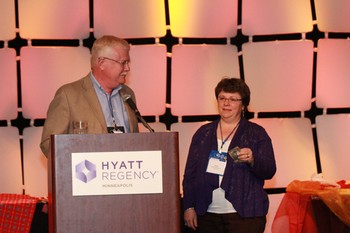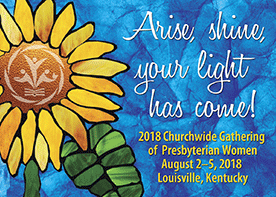
"Never bet against Presbyterian Women," PC(USA) Stated Clerk Gradye Parsons commented. In addition to leading a workshop, Gradye took the stage during a plenary session. He officially brought greetings from the PC(USA) and also made good on a bet with PW Executive Director Susan Jackson-Dowd that attendance for the PW Gathering would not be more than 1,000 people. Photo by Michael Martin.
On the road to where?
By Debbie McCanna
In a workshop during the 2015 PW Churchwide Gathering of Presbyterian Women, Stated Clerk Gradye Parsons gave attendees a lot of numbers, a lot of information and a lot of hope. The workshop, titled “State of the PC(USA),” was very popular at the Gathering, drawing hundreds to both sessions.
The numbers Gradye shared for the PC(USA) held with what has been reported for other mainline denominations—we have been losing members since the 1960s. Denominations even tend to lose members at about the same rate; of the total decline, 20 percent transfer, 20 percent dies and 60 percent drifts away.
The growth of the “Nones”—those who report their religious affiliation as “none” on the Pew Research Center’s 2014 U.S. Religious Landscape Study—has been a hot topic recently. Gradye said that in generations past, as young people drifted away from church, they often came back when they were getting married or having a baby. There’s no counting on that anymore; 88 percent of the Nones mark “Not Looking” when asked about their interest in finding a worshiping congregation.
But Gradye reminded workshop attendees that the Church’s fidelity is measured by our response to the rest of the world, not by who is in the pews. On 2015's Annual Statistical Report to the GA, congregations were asked to estimate the number of non-members they had impacted in the past year. With 40 percent of congregations responding, a total of 3.5 million contacts were reported. With average congregational size about 170, that works out to about 815 non-members touched by the faith and mission of each congregation. “And,” Gradye added, “PW is a big part of this work.”
He likened our new church model to the Antiochan Road. The early church grew exponentially, but members were cast out of their faith home and had to take to the road. They went to foreign territory, among diverse cultures and languages. They had to step out, evangelize and preach the good news in the public square, learning to become a church of diverse peoples, who loved each other despite (and because of) differences.
Indeed, our church must do this today, using new technology and a new picture of who belongs. Once we realize that the man who comes to the soup kitchen on Wednesday evening is as important a part of congregation as the two-child-mom-and-dad family in the pews on Sunday, we’ll be on the road to where we should be going. And that’s a hopeful road.

